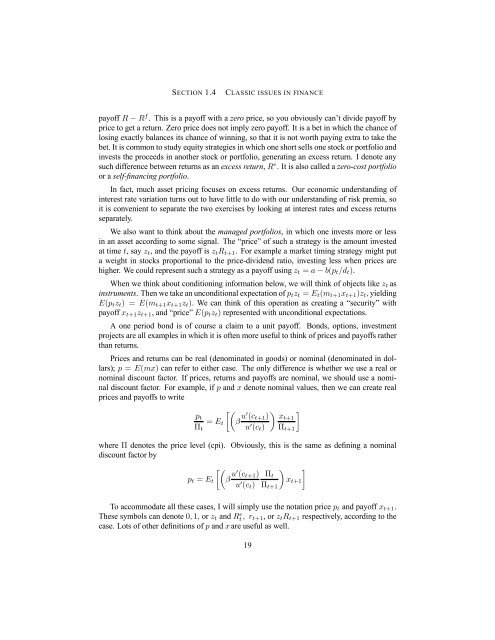Asset Pricing John H. Cochrane June 12, 2000
Asset Pricing John H. Cochrane June 12, 2000
Asset Pricing John H. Cochrane June 12, 2000
Create successful ePaper yourself
Turn your PDF publications into a flip-book with our unique Google optimized e-Paper software.
SECTION 1.4 CLASSIC ISSUES IN FINANCE<br />
payoff R − Rf . This is a payoff with a zero price, so you obviously can’t divide payoff by<br />
price to get a return. Zero price does not imply zero payoff. It is a bet in which the chance of<br />
losing exactly balances its chance of winning, so that it is not worth paying extra to take the<br />
bet. It is common to study equity strategies in which one short sells one stock or portfolio and<br />
invests the proceeds in another stock or portfolio, generating an excess return. I denote any<br />
such difference between returns as an excess return, Re . It is also called a zero-cost portfolio<br />
or a self-financing portfolio.<br />
In fact, much asset pricing focuses on excess returns. Our economic understanding of<br />
interest rate variation turns out to have little to do with our understanding of risk premia, so<br />
it is convenient to separate the two exercises by looking at interest rates and excess returns<br />
separately.<br />
We also want to think about the managed portfolios, in which one invests more or less<br />
in an asset according to some signal. The “price” of such a strategy is the amount invested<br />
at time t, sayzt, and the payoff is ztRt+1. For example a market timing strategy might put<br />
a weight in stocks proportional to the price-dividend ratio, investing less when prices are<br />
higher. We could represent such a strategy as a payoff using zt = a − b(pt/dt).<br />
When we think about conditioning information below, we will think of objects like zt as<br />
instruments. Then we take an unconditional expectation of ptzt = Et(mt+1xt+1)zt, yielding<br />
E(ptzt) =E(mt+1xt+1zt). We can think of this operation as creating a “security” with<br />
payoff xt+1zt+1, and “price” E(ptzt) represented with unconditional expectations.<br />
A one period bond is of course a claim to a unit payoff. Bonds, options, investment<br />
projects are all examples in which it is often more useful to think of prices and payoffs rather<br />
than returns.<br />
Prices and returns can be real (denominated in goods) or nominal (denominated in dollars);<br />
p = E(mx) can refer to either case. The only difference is whether we use a real or<br />
nominal discount factor. If prices, returns and payoffs are nominal, we should use a nominal<br />
discount factor. For example, if p and x denote nominal values, then we can create real<br />
prices and payoffs to write<br />
pt<br />
= Et<br />
Πt<br />
·µ<br />
β u0 (ct+1)<br />
u 0 (ct)<br />
xt+1<br />
Πt+1<br />
where Π denotes the price level (cpi). Obviously, this is the same as defining a nominal<br />
discount factor by<br />
pt = Et<br />
·µ<br />
β u0 (ct+1)<br />
u0 (ct)<br />
Πt<br />
Πt+1<br />
<br />
¸<br />
xt+1<br />
To accommodate all these cases, I will simply use the notation price pt and payoff xt+1.<br />
These symbols can denote 0, 1, or zt and R e t ,rt+1, orztRt+1 respectively, according to the<br />
case. Lots of other definitions of p and x are useful as well.<br />
19<br />
¸
















